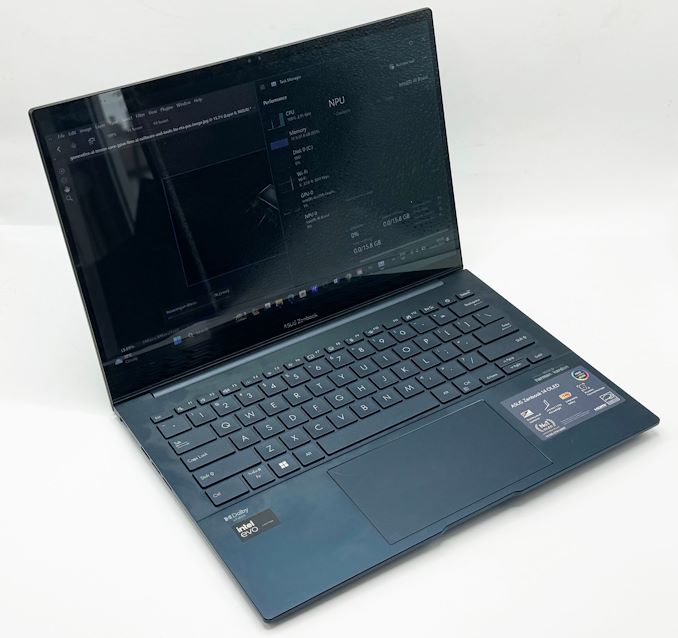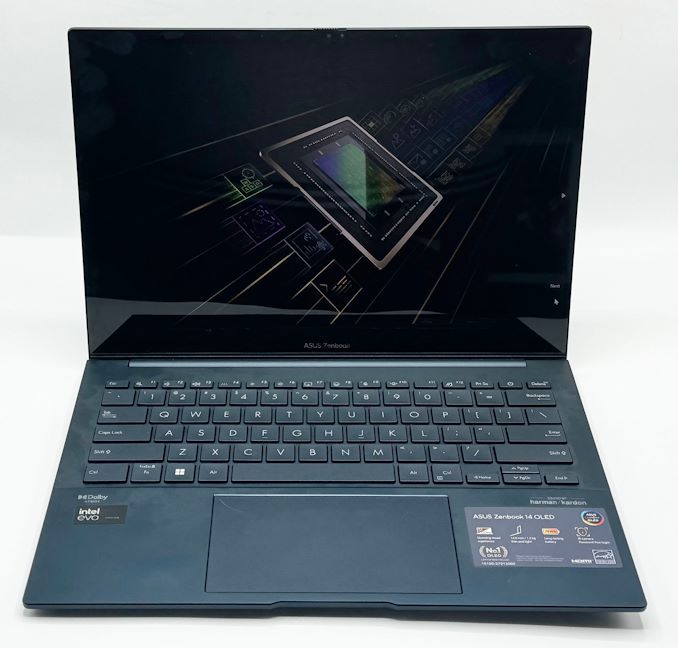The Intel Core Ultra 7 155H Review: Meteor Lake Marks A Fresh Start To Mobile CPUs
by Gavin Bonshor on April 11, 2024 8:30 AM ESTASUS Zenbook 14 OLED UX3405MA: Closer Look
The ASUS Zenbook 14 OLED is one of Intel's EVO-certified notebooks, offering plenty of style and substance within the thin 14.9 mm chassis. While ASUS hasn't provided information on what the chassis is built from, it does look and feel like an aluminum chassis, which doesn't feel particularly cheap and looks the part. As with the rest of the chassis on the ASUS Zenbook 14 OLED, the lid is made from the same aluminium-like material, and it looks very stylish with the Ponder Blue color.
At 312.4 x 220.1 x 14.99 mm (W x D x H), it's portable. The inclusion of the 14-inch 2.8K OLED display and a total weight of just 1.28 kg (2.82 lbs) makes it very capable for its size, as well as a very lightweight offering to travel with. For comparison, the Apple MacBook Air 13-inch (M3) weighs just 0.04 kg less.
Opening up the traditional clamshell design, we can see the 14-inch OLED panel dominating the top half, with the keyboard and the centrally located island-style trackpad. The trackpad doesn't have any discrete buttons, and instead is entirely touch-based. The keyboard keys themselves have a shallow key press and combine the cursor arrows with the (Fn) key functionality while offering a subtle white backlight behind the keyboard, making the Zenbook 14 OLED 'pop.' Although ASUS doesn't include a dedicated fingerprint scanner, along the top of the panel's bezel is a 1080p webcam with a privacy shutter with support for Windows Hello, which can be configured to provide IR face recognition without needing a PIN.
Touching on the display, with a 2.8 K (2800 x 1800) OLED panel, it's fair to say that with the brightness turned up, it's very vibrant and colorful, to say the least. The 14-inch display, according to the official specifications, has a peak brightness of 500 nits when using HDR, while it has a 400 nits peak brightness when HDR is turned off. It can cover 100% of the DCI-P3 color gamut, with a 0.2 ms response time. Regarding refresh rate, the panel supports 120 Hz, while ASUS allows users to switch between either 60 Hz or 120 Hz operation. The panel also has a capacitive touch layer, and ASUS includes a stylus within the packaging for this model.
Looking at the I/O on the ASUS Zenbook 14 OLED, ports and connectors are on both sides of the chassis. Focusing on the left side, it offers a single USB 3.2 G1 Type-A port towards the fold. Three ports look like connectors, but these are just ventilation gaps for airflow to escape.
On the right side are two Thunderbolt 4-capable USB Type-C ports, which support external displays and offer USB power delivery (USB-PD) capabilities. The Zenbook 14 OLED doesn't have a dedicated connector for charging, and instead relies on carging through its USB Type-C ports, with ASUS including a 65 W AC Type-C charger in the box. Also on the right-hand side is a single HDMI 2.1 video output and a single 3.5 mm combo audio jack. ASUS includes a USB Type-A to Ethernet adapter in the box, which I haven't seen for a while.
Overall, from looking at and considering the feel of the ASUS Zenbook 14 OLED UX3405MA, it's certainly a quaint premium 14-inch ultrabook. The bottom-mounted Harmon Kardon linear speakers, which don't look much, sound great and are certainly better than typical stock speakers. There's also the 14-inch OLED screen, which looks great and is vibrant and crystal clear, as expected from an OLED panel.
With a price tag (as configured) of $1299, the ASUS Zenbook 14 OLED UX3405MA is certainly a capable offering, which is powered by Intel's latest Core Ultra 7 155H Meteor Lake SoC, but style and design are one element; performance is perhaps the most important element.
ASUS Zenbook 14 OLED UX3405MA: Software
Before we examine the performance, we'll quickly examine the software bundle supplied. Everything on the ASUS Zenbook 14 OLED revolves around the MyASUS software, which acts as a centralized hub for functionality, profiles, updating drivers/software, and customization.
The MyASUS software has many different device settings that users can customize, such as enabling battery care mode, which limits battery charging beyond 80% immediately. Users can also select between three different fan profiles, including performance mode, which maximizes performance, although this does mean the notebook runs very loud. The other options include standard mode, which dynamically adjusts based on the temperatures, and whisper mode, which is very useful for watching moves in bed.
There are also many display-related options, including allocating more system memory to the integrated Arc Xe graphics and different visual profiles to select from depending on the task. Overall, there are plenty of functionalities within the MyASUS software hub, and having it all within a unified piece of software makes things much better for the overall user experience.


























69 Comments
View All Comments
lmcd - Wednesday, April 17, 2024 - link
That GloFo combo for Zen 2 and 3 never made it to an efficient mobile platform (HX technically exists but whatever).Intel 4 is an incomplete node. Intel 3 had better fix a lot of the issues because at this point, Intel's best bet looks like an entirely-TSMC SoC. Reply
James5mith - Friday, April 12, 2024 - link
"Meanwhile AMD does not offer a custom execution backend for this test, so while Windows ML is available as a fallback option to access the CPU and the GPU, it does not have access to AMD's NPU."So why are there no graph entries for the AMD GPU using Windows ML? You only show CPU results in the graph. Seems a bit disingenuous. Reply
Tams80 - Friday, April 12, 2024 - link
This is really a rather pathetic comparison. YouTubers can get their hands on more devices for comparison than this.I get it. AnandTech is a dying publication that doesn't have the influence it used to, to get devices. And this also leads to particularly fluffy pieces to appease the few companies that do provide review units. Reply
The Von Matrices - Friday, April 12, 2024 - link
How can a PCIe 4.0 x2 disk have a read speed of 5GB/s? The bus only has a transfer rate of 4GB/s. Replyskavi - Saturday, April 13, 2024 - link
> Starting with the Redwood Cove (P) core cluster on the Core Ultra 7 155H, we can see that the core-to-core access latencies across the P-cores ranges from 4.5 to 4.9 ns, which is very similar to that of Raptor Lake via the Core i5-14600K, which sits between 4.6 and 4.9 ns; this indicates that both have the same P-core topology.By core to core, you mean intercore, right? or hyperthread to hyperthread?
> For the E-cores, the latencies shoot up to between 57.9 and 74.8 ns per each L1 access point, with the two first E-cores having a latency of just 5.0 ns.
Am I going crazy? It seems obvious to me those “two first E-cores” are a single P-core. Reply
jpvalverde85 - Tuesday, April 16, 2024 - link
AI compute capability is just there, then the big cores are just good enough against Zen4, the IGP just as strong on the best scenario (drivers can get the better out of it but still weak on some titles), now overall if we cut IA outside, Meteor Lake gets spanked badly by a gen old Ryzen. The good is that everything seems to work even coming in different tiles for being a tech demo, but i suspect that the BOM of the Ryzen 9 7940HS is lower being a monolithic 180mm2 design, Intel probably had to spent a lot of "glue" per mm2 of silicon. Replylmcd - Wednesday, April 17, 2024 - link
The glue might not be cheap but TSMC 6nm sure is, and 5nm isn't wildly expensive either.This Intel 4 tile though is clearly so far from finished. This is a horrifying showing for Intel Foundry's fab capabilities even if their packaging is clearly fantastic. And we are so overdue for the current larger cores to get dropped and the design roadmap for Atom forked into a large and small core. Reply
shady28 - Wednesday, April 17, 2024 - link
Like other mentioned, these aren't comparable products.That really shows up when you look at the battery life comparisons. The 155H has a 75W-H batter vs 69W-H on the 7940HS, 9% more capacity. Yet it lasts 95% longer in the rundown test.
That's going to show up in performance too.
HotHardware has a much better comparison, a 165H against comparable products like the 7736U and Z1 Extreme (30W TDP), as well as last gen RL 1365U (15W / 55 max).
The 165H had the longest battery life in their test of any machine tested, 1/3 more than the Z1 Extreme. Reply
kkilobyte - Wednesday, April 24, 2024 - link
Have the SPEC2017 tests been adapted? The text still says to this day that the results will be adapted when they are available. Reply